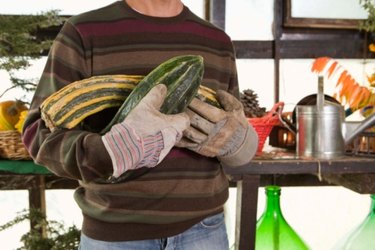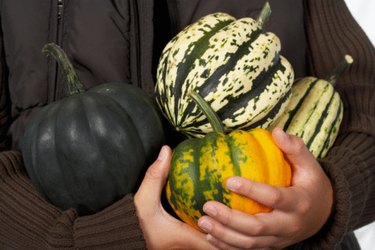Things You'll Need
Organic compost
Aged manure
Garden gloves
Shovel
Trowel
Rake

Kabocha squash, also known as Japanese pumpkin, is a deep green, bumpy skinned squash with white stripes, similar in shape to the traditional pumpkin. In Thailand, the flavorful squash is known as fak thong. Commonly, the Japanese pumpkin reaches a mature weight of 2 to 3 lbs., but it may grow to weigh up to 8 lbs. The flesh of Kabocha is a deep orange and is similar in taste and texture to a butternut squash. Kabocha squash is available at Asian markets and specialty produce vendors under the variety brand names Akazukin, Ebisu, Kurokawa and Miyako.
Step 1

Prepare the soil for planting. Japanese pumpkins, part of the plant genus Cucurbita, flourish in nutrient rich, well drained soil. Cover the garden space with a 2 to 3 inch layer of organic compost or well-aged herbivore manure. Cultivate to a depth of 12 inches, removing rocks, roots and weeds. Rake the soil to form raised rows or mounds, 12 to 18 inches high. Japanese pumpkins prefer a soil pH from 6.0 to 7.5.
Video of the Day
Step 2
Start Japanese pumpkins indoors, two to three weeks prior to the date of the expected last frost. Fill starter 2-inch peat pots with topsoil. Place one seed in each pot, planted 1 inch deep. Water well. Place in a sunny location. Keep the soil moist. Turn the pots every few days to prevent the plant from leaning toward the sunlight.
Step 3
Transplant the peat pots outdoors, in the prepared garden space, two to three weeks after the last frost. Plant the pot 1 inch under the soil surface. Japanese pumpkins require a good deal of space. Plant in mounds or rows spaced 6 to 8 feet apart. Plant several seed pots in each mound or plant in rows, 4 to 6 inches apart. When the plant has developed five to six distinct leaves, thin the seedlings to 8 to 12 inches apart. As the plants grow, train the vines to encircle the mound or follow the row. Vines grow from 12 to 20 feet in length.
Step 4
Water the plants regularly. Japanese pumpkins require about 1 inch of water per week. Do not allow the roots to dry out. Keep weeds removed from around the growing plant. Avoid planting Japanese pumpkins close to corn or other varieties of squash or pumpkins.
Tip
Japanese pumpkins like warm days with temperatures between 70 and 79 F and night temperatures of 55 to 60 F. The squash requires 90 to 120 days to reach maturity.
Video of the Day